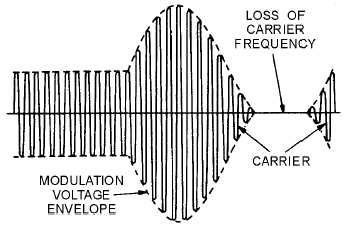5-6
modulated wave to the vertical input of the oscilloscope. The trapezoidal pattern is obtained in a similar
manner except that the modulation signal from the transmitter is used to horizontally sweep the
oscilloscope (instead of having the sweep signal generated internally by the oscilloscope). Both methods
are limited by the frequency response of the oscilloscope; therefore, these methods find greater
applicability in the lf to hf ranges.
Figure 5-5.—Overmodulated rf carrier.
VHF AND UHF MEASUREMENTS
In the vhf and uhf ranges, modulation is normally measured by applying a specific-level, 1-kilohertz
tone to the input of the modulator. This, in turn, produces a significant drop in the plate voltage of the
final output stage of the modulator. The correct setting of output plate voltage ensures that
overmodulation will not occur.
SINGLE-SIDEBAND MEASUREMENTS
Single-sideband modulation is a form of amplitude modulation in which only one sideband is
transmitted with a suppressed carrier. Since balanced modulators are used to provide carrier cancellation,
the exact balancing of the carriers to provide cancellation requires a null adjustment. The null can be
observed and adjusted by using either a detector and an indicator, such as a voltmeter, or an oscilloscope
for observation of the output while tuning the transmitter.
Measurements peculiar to sideband technology also include special modulation-amplitude and
modulation-distortion checks. If the sideband modulator is overdriven or mistuned or the associated linear
amplifiers are improperly loaded or overdriven, spurious output frequencies are produced. These are
harmonically related to the driving signals and can cause splatter over a large range of frequencies, thus
causing interference to other transmitting stations.
To determine the proper amplitude so that the modulation will not cause distortion or splatter, you
use the audio two-tone modulation test. The resulting signals are shown in views A, B, and C of figure 5-
6. The two-tone test is used for initial adjustment and for precise checking because it will indicate
distortion. The two-tone test corresponds to the wave envelope method of AM modulation checking. Two
signals of equal amplitude but of slightly different frequencies beating together are applied to the
sideband modulator input to produce a single tone of approximately 1,000 hertz. On an oscilloscope, the

